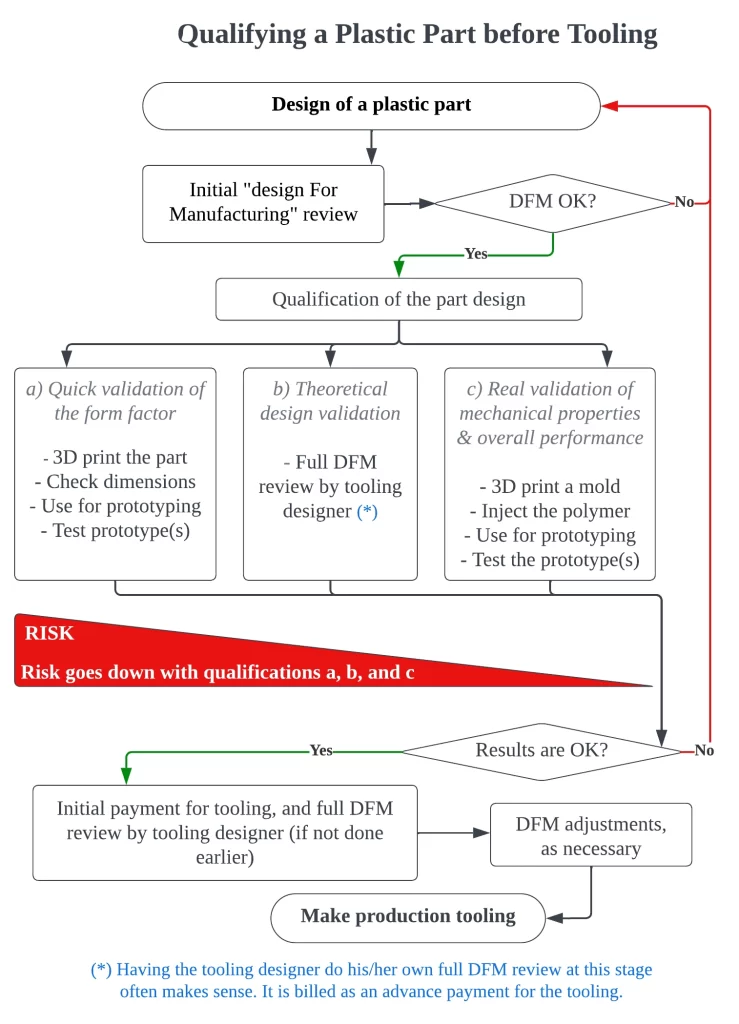In our previous post, What are Plastic Injection Mold Tooling Revisions? (+ real examples), we explored real-world examples of tooling revisions—how unexpected design changes led to costly mold modifications, production delays, and even complete re-fabrication. From minor adjustments like adding support ribs to major overhauls requiring new molds, these case studies underscored a crucial lesson: tooling revisions can be expensive and time-consuming, but their impact can be minimized — and maybe they can be largely prevented — with the right approach.
While there’s no silver bullet to eliminate revisions entirely, adopting good practices can significantly reduce the risk. Rushing into mold fabrication without fully validating a design can result in painful rework.
Fortunately, strategies like 3D printing, Fast Iterative Molding (FIT), and in-depth DFM (Design for Manufacturing) reviews help minimize these risks.
In this post, let’s look at some tangible best practices to help you avoid costly revisions.
Best practices for avoiding mold tooling revisions
Qualifying plastic parts during development and prototyping is critical for avoiding costly tooling revisions later on. Here’s the process we would suggest for many projects:

Based on that process, here are the best practices we suggest.
- Make sure you validate the whole product design first. In many projects, the company decides to start tooling fabrication relatively early in order to reduce time to market, but later they realize they need to make design changes that lead to revising or even re-making molds from scratch.
- Do not go from CAD drawings into tooling. Always 3D print the parts, check dimensional accuracy, and validate their design that way. Keep in mind the limitations of such samples.
- If there is uncertainty about the exact properties/behavior of the parts once they are made with production tooling, it may make sense to 3D print simple tooling that can be used for a few injection shots. There are now solutions for making molds that allow for easy demolding, even when there are undercuts. We call it FIT (“Fast Iterative Molding”). It may also, in some cases, involve hybrid tooling (i.e. metal + plastic parts making up the mold).
- The more robust the part design, the higher the chance that the expected result is achieved when using production tooling. If a part is designed in a way that is realistic in theory but is very challenging for a manufacturing team, the risk is very high. Maybe the result the manufacturing team says is the “best we can achieve consistently” is not acceptable, which means the design needs to change, and often it is the result of a lack of robustness.
- The structural & mechanical engineers should follow good DFM (“design for manufacturing”) practices during the design of the part(s). The drawings need to be reviewed by experienced engineers.
- Ideally, the tooling fabrication team does a proper DFM review when there is still time to re-think the design of the part(s).
Additional tips
- Only design your own custom plastic parts when available off-the-shelf parts are not able to fulfil your requirements.
- In general, the softer the mold, the easier and faster it is to machine. Adjustments on soft steel or aluminum tend to be cheaper and faster. On the other end of the spectrum, welding extra material on a hardened steel mold is difficult and may be a no-no because it affects the life of the mold (it often causes welding marks on the surface of a high-gloss and texturing mold, affecting the appearance of the product).
- The simpler and smaller a mold, in general, the faster and cheaper it is to revise. The risk is lower with a 1-cavity mold than a 4-cavity mold.
Conclusion: Plan ahead to avoid costly tooling revisions
Tooling revisions aren’t uncommon when developing new products, but as we’ve seen, they can be an unwelcome delay and cost. You can reduce the risk of needing them by strategically thinking ahead about validating your product designs early, using innovative prototyping methods like 3D printing and FIT, and following solid DFM principles.
Our top tip? Taking time to do thorough design validation before committing to tooling can save you weeks, if not months, of costly rework.



